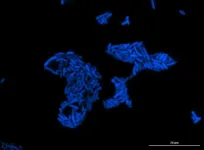Head and neck cancer cells hijack nearby healthy tissue, promoting further invasion of cancer cells
2021-05-26
(Press-News.org) Up to half of patients with head and neck squamous cell carcinoma will experience tumor recurrence or new tumors--tumors that often spread and are difficult to treat.
A team of scientists led by the University of Michigan School of Dentistry identified a mechanism by which head and neck cancer cells subvert adjacent normal tissue, allowing small clusters of cancer cells to burrow beneath the healthy tissue.
The team decided to look at this particular mechanism in head and neck cancer because a specific gene, DMBT1, appeared on a screen of genes that are silenced during oral cancer, said principal investigator Nisha D'Silva, the Donald A. Kerr Endowed Collegiate Professor of Oral Pathology.
Researchers from the D'Silva lab found that when DMBT1 was suppressed in head and neck cancer cells, it promoted aggressive invasion and metastasis in laboratory studies
and was associated with metastasis in patients.
They also found that two proteins secreted by head and neck cancer cells suppress DMBT1 in nearby ?healthy tissue, subverting it to promote invasion of a small amount of cancer cells, which burrow under healthy tissue.
Researchers looked at this mechanism in mice, chick embryos and cultures of human cancer cells. ??In the chick embryos, none of the tumors that overexpressed DMBT1 metastasized, whereas most of the control tumors that had low DMBT1 metastasized, D'Silva said.
"The importance of this paper is that loss of DMBT1 in cancer cells and adjacent normal tissue benefits cancer cells, allowing them to travel in tiny groups away from the main tumor," she said. "That is why cancer cells enlist the help of the adjacent tissue. Finding ways to interrupt this communication and enhance DMBT1 expression could help improve outcome."
The findings, published in the Journal of Experimental Medicine, could open possibilities for new therapeutics that target proteins in cancer cells that regulate DMBT1 and could have implications for other cancers in which DMBT1 expression is altered, D'Silva said.
"We are familiar with cancer cells enlisting the help of other cell types to grow and spread," she said. "Our research demonstrated that cancer cells also communicate with healthy cells of their own cell type to facilitate spread."
Head and neck cancer is the sixth most common cancer in the world, with 600,000 new cases annually.
INFORMATION:
Study abstract: Squamous cell carcinoma subverts adjacent histologically normal epithelium to promote lateral invasion
ELSE PRESS RELEASES FROM THIS DATE:
2021-05-26
ITHACA, N.Y. - Approximately one-third of all U.S. counties do not exempt grocery foods from the general sales tax, which means the lowest-income families living in those areas are most susceptible to food insecurity. New research from Cornell University finds that even a slight grocery tax-rate increase could be problematic for many.
"An increase of 1% to 4% may sound small, but after several trips to the grocery store, the extra costs can create serious burdens for the lowest-income families," said co-author Harry Kaiser, professor of applied economics and management in the Charles H. Dyson School of Applied ...
2021-05-26
The carefully orchestrated dance between the immune system and the viral proteins that induce immunity against COVID-19 may be more complex than previously thought. A new study by investigators at Brigham and Women's Hospital used an ultrasensitive, single-molecule array (Simoa) assay to detect extremely low levels of molecules in the blood and measured how these levels change over the days and weeks following vaccination. The team found evidence of circulating protein subunits of SARS-CoV-2, followed by evidence of the body mounting its immune response and then clearing the viral protein to below the level of single-molecule detection. Results are published in Clinical Infectious Diseases.
"Because of ...
2021-05-26
Bacteria called methylotrophs can use methane and methanol as fuel; in doing so, they produce large amounts of formaldehyde during growth, but until recently no one knew how they detected and responded to this toxic compound. Publishing on 26th May, 2021 in the Open Access journal PLOS Biology, Christopher Marx of the University of Idaho and colleagues describe their discovery of a novel formaldehyde sensor in the bacterium Methylorubrum extorquens, and other methylotrophs.
Some may remember the pungent smell of this toxic chemical from high school dissections of formaldehyde-preserved animals. From bacteria to humans, all organisms produce at least a little formaldehyde ...
2021-05-26
May 26, 2021, CLEVELAND: According to new findings published in Science Translational Medicine, Cleveland Clinic researchers have identified a promising drug target for treating and preventing aggressive, drug-resistant prostate cancer.
The team, led by Nima Sharifi, M.D., of Cleveland Clinic's Lerner Research Institute, demonstrated that inhibiting the protein H6PD led to significantly reduced tumor sizes and improved survival among mouse models with drug-resistant prostate cancer. The H6PD levels also were elevated in biopsied patient tumors, suggesting the protein might be targeted ...
2021-05-26
Milwaukee, May 26, 2021 - A non-opioid based target has been found to alleviate chronic touch pain and spontaneous pain in mice. Researchers at the Medical College of Wisconsin (MCW) discovered that blocking transient receptor potential canonical 5 (TRPC5) activity reversed touch pain in mouse models of sickle cell disease, migraine, chemotherapy-related pain, and surgical pain.
TRPC5 is a protein that is expressed in both mouse and human neurons that send pain signals to the spinal cord. The findings were published in Science Translational Medicine. The senior and co-first authors of the manuscript, respectively, are MCW researchers ...
2021-05-26
What if a robot could organize your closet or chop your vegetables? A sous chef in every home could someday be a reality.
Still, while advances in artificial intelligence and machine learning have made better robotics possible, there is still quite a wide gap between what humans and robots can do. Closing that gap will require overcoming a number of obstacles in robot manipulation, or the ability of robots to manipulate environments and adapt to changing stimuli.
Ph.D. candidate Jinda Cui and Jeff Trinkle, Professor and Chair of the Department of Computer Science and Engineering ...
2021-05-26
PITTSBURGH, May 26, 2021 - In a paper published today in Science Advances, researchers from the University of Pittsburgh School of Medicine showed that inhalable nanobodies targeting the spike protein of the SARS-CoV-2 coronavirus can prevent and treat severe COVID-19 in hamsters. This is the first time the nanobodies--which are similar to monoclonal antibodies but smaller in size, more stable and cheaper to produce--were tested for inhalation treatment against coronavirus infections in a pre-clinical model.
The scientists showed that low doses of an aerosolized nanobody named Pittsburgh inhalable Nanobody-21 (PiN-21) protected hamsters from the dramatic weight loss ...
2021-05-26
An inhalable nanobody-based treatment may effectively prevent and treat SARS-CoV-2 infections when administered at ultra-low doses, according to a new study in Syrian hamsters. This novel therapy, Pittsburgh inhalable Nanobody 21 (PiN-21), could provide an affordable, needle-free alternative to monoclonal antibodies for treating early infections. Sham Nambulli and colleagues recently developed PiN-21, which uses single-domain antibody fragments that are cheaper to produce than monoclonal antibodies. However, until this study, the efficacy of PiN-21 had not been reported in living organisms. To advance the development of this treatment, Nambulli et al. administered a 0.6 milligram per kilogram ...
2021-05-26
Piscine orthoreovirus (PRV) - which is associated with kidney and liver damage in Chinook salmon - is continually being transmitted between open-net salmon farms and wild juvenile Chinook salmon in British Columbia waters, according to a new genomics analysis published today in Science Advances.
The collaborative study from the University of British Columbia (UBC) and the Strategic Salmon Health Initiative (SSHI) -- a partnership between Fisheries and Oceans Canada (DFO), Genome BC and the Pacific Salmon Foundation -- traces the origins of PRV to Atlantic salmon farms in Norway and finds that the virus is now almost ubiquitous in salmon farms in B.C.
It also shows that wild Chinook salmon are more likely to be infected with ...
2021-05-26
Jodi Karnell and colleagues have developed a monoclonal antibody, VIB7734, that reduces symptom severity in people with cutaneous lupus by targeting and depleting plasmacytoid dendritic cells (pDC) in blood and skin. In two phase I clinical trials involving a total of 67 people with autoimmune diseases such as lupus, treatment with VIB7734 was as safe as a placebo and significantly reduced pDC frequencies, the researchers found. The antibody also reduced the activity of a group of key immune proteins called type 1 interferons in skin. Both pDCs and type 1 interferons are suspected ...
LAST 30 PRESS RELEASES:
[Press-News.org] Head and neck cancer cells hijack nearby healthy tissue, promoting further invasion of cancer cells


